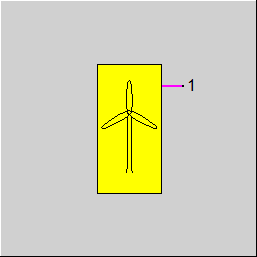

|
Line connections |
|
|
|
1 |
Power outlet |
|
General User Input Values Results Displays Example
Component 143 represents a wind turbine. Based on the power curve provided by the manufacturer of the wind turbine, the generated electrical output is determined depending on the mean wind speed at hub height.
The relation between the power output P of a wind turbine, the undisturbed wind speed v1 at hub height, and the power coefficient cP is as follows:

Specification of voltage, frequency and type of current in the component:
It is possible to specify the voltage (VOLT), frequency (FREQ) and type of current (NPHAS) as the default value in the component.
The flags FVOLT and FFREQ are used to set whether the specification is to be made by the new specification values VOLT and FREQ respectively (0) or externally as a measured values on the electrical line (-1).
Warning!: A warning will be output if the minimum hub height is fallen below.
Data from various manufacturers have been stored in the default value database for this component.
|
TYPENAME |
Wind turbine type name |
|
FFU |
Turbine switched =0: OFF =1: ON |
|
IWDATA |
Index for comp.142, to use wind parameters |
|
FIDENT |
Calculation mode =0: Simulation - wind speed given, output power computed ,using power curve =1: Identification - wind speed and output power given, power coefficient computed |
|
ROTDIAM |
Rotor diameter |
|
HH |
Hub height |
|
HHMIN |
Minimum hub height |
|
Z0 |
Roughness length |
|
FVWHH |
Handling of the wind speed at hub height =0: use directly the value of VWHH =1: recompute the value of VWIND from comp. 142 to the hub height using logarithmic vertical velocity profile ( Algorithm 1 of comp. 142) =2: recompute the value of VWIND from comp. 142 to the hub height using logarithmic vertical velocity profile and Monin-Obukhov length acc. to TA Luft, VDI 3783-8 Bl. 1 and VDI 3783 Bl. 8 ( Algorithm 2 of comp. 142) |
|
VWHH |
Wind speed at hub height |
|
FFW |
Use power correction factor FW =0: OFF =1: ON |
|
FVOLT |
Flag for the method for specification of voltage =0: Defined by specification value VOLT =-1: Voltage given externally on electrical outlet |
|
VOLT |
Voltage (on electric lines) |
|
FFREQ |
Flag for the method for specification of frequency =0: Use specification value FREQ =-1: Frequency given externally on electrical outlet |
|
FREQ |
Generator frequency |
|
NPHAS |
Type of current =0: Direct current =1: One-phase alternating current |
|
AS |
Swept area |
|
RVWHH |
Computed wind speed at hub height without normalization acc. to IEC-61400-12-1 |
|
RVWHHIEC |
Computed wind speed at hub height normalized acc. to IEC 61400-12-1 |
|
CP |
Overall power coefficient |
|
Char.line 1: Power produced Q1 = f (VWHHIEC) (Wind speed at hub height normalized acc. to IEC) |
|
X-Axis 1 VWHHIEC 1. Point |
MXFW : Power correction factor FW depending on the wind speed at hub height normalized acc. to IEC 61400-12-1 and wind direction
 |
Display option 1 |
Click here >> Component 143 Demo << to load an example.